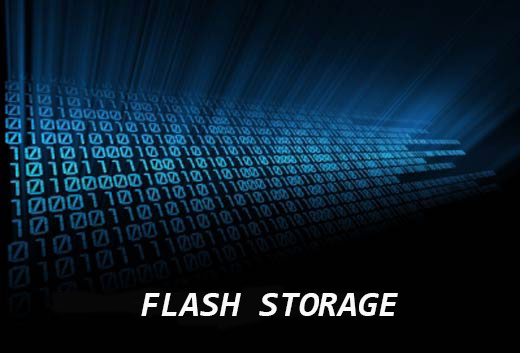FLASH STORAGE – IS IT THE RIGHT CHOICE FOR YOU?

In my last post I wrote about the importance of understanding your current environment before setting out on a search for new data storage solutions. Understanding your Usable Capacity requirements, Data Characteristics, and Workload Profiles is essential when evaluating the many storage options available. Once you have assessed and documented your requirements, you should spend some time understanding the many technologies being offered with today’s shared storage solutions.
Currently, one of the most talked about shared storage technologies is Flash storage. While Flash technology isn’t new, it is more prevalent now than ever before in shared storage solutions. To help you determine whether or not Flash storage is relevant for your environment, I wanted to touch on answers to some of the basic questions regarding this technology. What is Flash storage? What problem does it solve? What considerations are unique when considering shared Flash storage?
In simple terms, Flash Storage is an implementation of non-volatile memory used in Solid State Drives (SSD) or incorporated on to a PCIe card. Both of these implementations are designed as data storage alternatives to Hard Disk Drives (HDD/”spinning disk”). In most shared storage implementations, you’ll see SSD; and that’s what we’ll talk about today.
As you begin looking at Flash storage options you’ll see them defined by one of the following technologies:
SLC – Single Level Cell
MLC – Multi-level Cell
- eMLC – Enterprise Multi-level Cell
- cMLC – Consumer Multi-level Cell
There is a lot of information available on the internet to describe each of the SSD technologies in detail; so, for the purpose of this post, I’ll simply say that SLC is the most expensive of these while cMLC is the least expensive. The cost delta between the SSD technologies can be attributed to reliability and longevity. Given this statement, you might be inclined to disregard any of the MLC solutions for your business critical environment and stick with the solutions that use only SLC. In the past this may have been the right choice; however, the widespread implementation of Flash storage in recent years has brought about significantly improved reliability of MLC. Consequently, you’ll see eMLC and cMLC implemented in many of the Flash storage solutions available today.
Beyond the cell technology, there are three primary implementations of SSD used by storage manufacturers for their array solutions. Those implementations are:
- All Flash – As you might have guessed, this implementation uses only SSD, without the possibility of including an HDD tier.
- Flash + HDD – These solutions use a tier of SSD and usually provide a capacity tier made up of Nearline HDD. These solutions often provide automated tiering to migrate data between the two storage tiers.
- Hybrid – These solutions offer the choice of including SSD along with HDD and can also offer the choice of whether or not to implement automated tiering.
 So why consider SSD at all for your shared storage array? Because SSD has no moving parts, replacing HDD with SSD can result in a reduction of power and cooling requirements, especially for shared storage arrays where there can be a large number of drives. However, the most touted advantage of SSD over HDD is speed. SSD is considered when HDD isn’t able to provide an adequate level of performance for certain applications. There are many variables that impact the actual performance gain of SSD over HDD, but it isn’t unrealistic to expect anywhere from 15 to 50 times the performance. So, as you look at the solution options available for storage arrays that incorporate SSD, keep in mind that your primary reason for utilizing Flash is to achieve better performance of one or more workloads.
So why consider SSD at all for your shared storage array? Because SSD has no moving parts, replacing HDD with SSD can result in a reduction of power and cooling requirements, especially for shared storage arrays where there can be a large number of drives. However, the most touted advantage of SSD over HDD is speed. SSD is considered when HDD isn’t able to provide an adequate level of performance for certain applications. There are many variables that impact the actual performance gain of SSD over HDD, but it isn’t unrealistic to expect anywhere from 15 to 50 times the performance. So, as you look at the solution options available for storage arrays that incorporate SSD, keep in mind that your primary reason for utilizing Flash is to achieve better performance of one or more workloads.
Historically, we have tried to meet performance demands of high I/O workloads by using large numbers of HDD; the more spinning disks you have reading and writing data, the better your response time will be. However, to achieve adequate performance in this way, we often ended up with far more capacity than required. When SSD first started showing up for enterprise storage solutions, we had the means to meet performance requirements with fewer drives. However, the drives were so small (50GB, 100GB) that we needed to be very miserly with what data was placed on the SSD tier.
Today you’ll find a fairly wide range of capacity options, anywhere from 200GB to 1.92TB per SSD. Consequently, you won’t be challenged trying to meet the capacity requirements of your environment. Given this reality you may be tempted to simply default to an All Flash solution. But, because SSD solutions are still much more expensive than HDD, you want to make sure to match your unique workload requirements accordingly. For instance, it may not make sense for you to pay the SSD premium to support your user file shares; but you might want to consider SSD for certain database requirements or for VDI. This is where you’ll be thankful that you took the time to understand your capacity and workload requirements.
When trying to achieve better performance of your applications, don’t let the choice of SSD be your only consideration. Remember, resolving a bottleneck in one part of the I/O path may simply move the bottleneck somewhere else. Be sure you understand the limitations of the controllers, fibre channel switches, network switches, and HBA’s.
Finally, you’ll need to understand how manufacturers can differentiate their implementation of Flash technology. Do they employ Flash optimization? Is Deduplication, compaction, or thin provisioning part of the design? Manufacturers may use the same terminology to describe these features, but their implementation of the technology may be very different. I’ll cover some of these in my next blog post. In the meantime, you may want to review the 2015 DCIG Flash Memory Buyers Guide.
Categories
Search
Blog Categories
Related Resources
Archives
- October 2023
- September 2023
- August 2023
- July 2023
- June 2023
- May 2023
- April 2023
- March 2023
- February 2023
- January 2023
- October 2022
- July 2022
- June 2022
- May 2022
- April 2022
- March 2022
- February 2022
- January 2022
- December 2021
- November 2021
- October 2021
- September 2021
- August 2021
- July 2021
- June 2021
- May 2021
- April 2021
- March 2021
- February 2021
- January 2021
- December 2020
- November 2020
- October 2020
- September 2020
- August 2020
- July 2020
- June 2020
- May 2020
- April 2020
- March 2020
- February 2020
- January 2020
- December 2019
- November 2019
- October 2019
- September 2019
- August 2019
- July 2019
- June 2019
- May 2019
- April 2019
- March 2019
- February 2019
- January 2019
- December 2018
- November 2018
- October 2018
- September 2018
- August 2018
- July 2018
- June 2018
- May 2018
- April 2018
- March 2018
- February 2018
- January 2018
- December 2017
- November 2017
- October 2017
- September 2017
- August 2017
- July 2017
- June 2017
- May 2017
- April 2017
- March 2017
- February 2017
- January 2017
- December 2016
- November 2016
- October 2016
- September 2016
- August 2016
- July 2016
- June 2016
- May 2016
- March 2016
- February 2016
- January 2016
- December 2015
- October 2015
- September 2015
- August 2015
- July 2015
- June 2015
- May 2015
- April 2015
- March 2015
- February 2015
- January 2014
- February 2013

